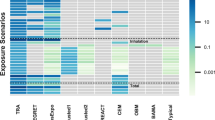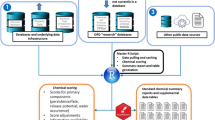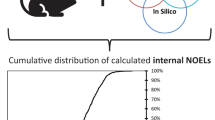Abstract
Children’s consumer products represent an important exposure source for many toxicants. Chemicals of high concern, as designated by the Washington State Child Safe Product Act include phthalates, Bisphenol A (BPA) and parabens, among others. As regulation and reporting requirements increase, so has demand for safer alternatives. This project examines how predictive toxicology and exposure comparison tools can fill gaps in alternatives assessments for hazardous chemicals found in children’s products. Phthalates, parabens, BPA and their alternatives were assessed for endocrine disruption and reproductive toxicity using authoritative lists and US Environmental Protection Agency’s (EPA) predictive toxicology and exposure comparison tools. Resources included the European Chemical Agency’s Endocrine Disruptor Substances of Concern database, Global Harmonization System and Classification of Labeling Chemicals, Quantitative Structural Activity Relationships from the Toxicity Estimation Software Tool, the Toxicological Prioritization Index (ToxPi) score calculated from the ToxCast Database, and No Observable Adverse Effects Levels (NOAELs)/Highest No Effects Levels (HNEL) from animal studies found in the CompTox Chemistry Dashboard. Exposure was assessed using ExpoCast predictions. Though alternatives were rarely included in authoritative lists, predictive toxicology tools suggested that BPA alternatives may not be safer but paraben and phthalate alternatives may be safer. All four paraben and no bisphenol or phthalate alternatives were listed on EPA’s Safer Chemical Ingredients List. Overall, we found that predictive toxicology tools help fill gaps for alternatives assessments when existing classifications are incomplete.
This is a preview of subscription content, access via your institution
Access options
Subscribe to this journal
Receive 6 print issues and online access
$259.00 per year
only $43.17 per issue
Buy this article
- Purchase on Springer Link
- Instant access to full article PDF
Prices may be subject to local taxes which are calculated during checkout





Similar content being viewed by others
References
Anastas PT, Warner JC, Green. Chemistry: Theory and Practice. Oxford University Press: New York; 1998.
The National Academy of Sciences Press. A Framework to Guide Selection of Chemical Alternatives. 2014. https://www.nap.edu/catalog/18872/a-framework-to-guide-selection-of-chemical-alternatives.
Interstate Chemical Clearninghouse. IC2 Alternatives Assessment Guide. 2014. http://www.theic2.org/alternatives_assessment_guide.
United States Environmental Protection Agency. What are the Key Steps to Conducting an Alternatives Assessment. https://www.epa.gov/saferchoice/design-environment-alternatives-assessments.
Office of Economic Cooperation and Development. Current landscape of alternatives assessment practice: a meta-review. 2014 http://www.oecd.org/officialdocuments/publicdisplaydocumentpdf/?cote=ENV/JM/MONO(2013)24&docLanguage=En.
Faustman and Omenn. Risk Assessment. In Klaassen CD, editor, Casarett and Doull’s toxicology: the basic science of poisons. 9th edn. McGraw-Hill: New York; 2019.
Tickner, J, Jacobs, M, Malloy, T, Buck, T, Stone, A, Blake, A et al. Advancing alternatives assessment for safer chemical substitution: a research and practice agenda. Integr Environ Assess Manag. 2018. https://doi.org/10.1002/ieam.4094.
United States Food and Drug Administration, US. Food Additive Regulations Amended to No Longer Provide for the Use of BPA-Based Materials in Baby Bottles, Sippy Cups, and Infant Formula Packaging. 2012. http://www.fda.gov/newsevents/publichealthfocus/ucm064437.htm#regulations.
Vandenberg LN, Prins GS. Clarity in the face of confusion: new studies tip the scales on bisphenol A (BPA). Andrology. 2016;4:561–4. https://doi.org/10.1111/andr.12219.
Lioy PJ, Hauser R, Gennings C, Koch HM, Mirkes PE, Schwetz BA, et al. Assessment of phthalates/phthalate alternatives in children's toys and childcare articles: review of the report including conclusions and recommendation of the Chronic Hazard Advisory Panel of the Consumer Product Safety Commission. J Expo Sci Environ Epidemiol. 2015;25:343–53.
Kinch CD, Ibhazehiebo K, Jeong J-H, Habibi HR, Kurrasch DM. Low-dose exposure to bisphenol A and replacement bisphenol S induces precocious hypothalamic neurogenesis in embryonic zebrafish. Proc Natl Acad Sci. 2015;112:1475–80. https://doi.org/10.1073/pnas.1417731112.
Rochester JR, Bolden AL. Bisphenol S and F: a systematic review and comparison of the hormonal activity of bisphenol A substitutes. Environ Health Perspect. 2015;123:643–50. https://doi.org/10.1289/ehp.1408989.
United States Comsumer Product Safety Comission., Us Consumer Product Safety Improvement Act of 2008. https://www.cpsc.gov/s3fs-public/pdfs/blk_pdf_cpsia.pdf.
Washington State Department of Ecology. Children's Safe Product Act. 2016. http://www.ecy.wa.gov/programs/hwtr/RTT/cspa/.
AH T. Plasticizer Makers Want a Piece of the Phthalate Pie. Chem Eng News. 2015;93:16–8. https://cen.acs.org/articles/93/i25/Plasticizer-Makers-Want-Piece-Phthalates.html.
Lowell center for sustainable production. technical briefing: phthalates and their alternatives: health and environmental concerns. 2011. http://ec.europa.eu/environment/aarhus/pdf/35/Annex_11_report_from_Lowell_Center.pdf.
Wong KH, Durrani TS. Exposures to endocrine disrupting chemicals in consumer products-A guide for pediatricians. Curr Probl Pediatr Adolesc health care. 2017;47:107–18. https://doi.org/10.1016/j.cppeds.2017.04.002.
Benvenuti, N. 3 reasons why paraben alternatives might be worse than parabens. FutureDerm. 2014. https://www.futurederm.com/3-reasons-why-paraben-alternatives-might-be-worse-than-parabens/.
Klaus, W. New Alternative to paraben-based preservative blends. Schulke and Myr GmbH, Nordestedt Germany 2018. http://www.schulkemicrosites.de/media-cosmetic-preservation/Literature/New-Alternatives-to-Paraben-Based-Preservative-Blends-C-T-2005.pdf.
United States Environmental Protection Agency. 2018. https://www.epa.gov/saferchoice/safer-ingredients#scil. Safer Chemical Ingredents List; Accessed 10 Aug 2018.
European Chemicals Agency. Endocrine disruptions: substances of concern. http://ec.europa.eu/environment/chemicals/endocrine/strategy/substances_en.htm#priority_list.
Global Harmonization System. http://www.safe.nite.go.jp/english/ghs/ghs_index.html. Accessed 10 May 2018.
Pham N, Iyer S, Hackett E, Lock BH, Sandy M, Zeise L, et al. Using ToxCast to explore chemical activities and hazard traits: a case study with ortho-phthalates. Toxicol Sci: Off J Soc Toxicol. 2016;151:286–301. https://doi.org/10.1093/toxsci/kfw049.
Reif David M, Martin Matthew T, Tan Shirlee W, Houck Keith A, Judson Richard S, Richard Ann M, et al. Endocrine profiling and prioritization of environmental chemicals using ToxCast data. Environ Health Perspect. 2010;118:1714–20. https://doi.org/10.1289/ehp.1002180.
Filer D, Patisaul HB, Schug T, Reif D, Thayer K. Test driving ToxCast: endocrine profiling for 1858 chemicals included in phase II. Curr Opin Pharm. 2014;19:145–52. https://doi.org/10.1016/j.coph.2014.09.021.
Williams AJ, Grulke CM, Edwards J, McEachran AD, Mansouri K, Baker NC, et al. The CompTox chemistry dashboard: a community data resource for environmental chemistry. J Chemin-. 2017;9:017–0247.
United States Environmental Protection Agency. Toxicity Estimation Software Tool Version 4.2 User Manual. https://www.epa.gov/sites/production/files/2016-05/documents/600r16058.pdf. 2016.
Cassano A, Manganaro A, Martin T, Young D, Piclin N, Pintore M, et al. CAESAR models for developmental toxicity. Chem Cent J. 2010;4:S4. https://doi.org/10.1186/1752-153x-4-s1-s4.
Wambaugh JF, Wang A, Dionisio KL, Frame A, Egeghy P, Judson R, et al. High throughput heuristics for prioritizing human exposure to environmental chemicals. Environ Sci Technol. 2014;48:12760–7. https://doi.org/10.1021/es503583j.
Phillips KA, Wambaugh JF, Grulke CM, Dionisio KL, Isaacs KK. High-throughput screening of chemicals as functional substitutes using structure-based classification models. Green Chem. 2017;19:1063–74. https://doi.org/10.1039/C6GC02744J.
Malloy T, Zaunbrecher V, Beryt E, Judson R, Tice R, Allard P, et al. Advancing alternatives analysis: the role of predictive toxicology in selecting safer chemical products and processes. Integr Environ Assess Manag. 2017;13:915–25. https://doi.org/10.1002/ieam.1923.
Jacobs MM, Malloy TF, Tickner JA, Edwards S. Alternatives assessment frameworks: research needs for the informed substitution of hazardous chemicals. Environ Health Perspect. 2016;124:265–80. https://doi.org/10.1289/ehp.1409581.
Williams AJ, Grulke CM, Edwards J, McEachran AD, Mansouri K, Baker NC, et al. The CompTox chemistry dashboard: a community data resource for environmental chemistry. J Chemin-. 2017;9:61. https://doi.org/10.1186/s13321-017-0247-6.
Malloy, TF, Zaunbrecher, VM, Batteate, CM, Blake, A, Carroll, WF, Jr., Corbett, CJ et al. Advancing Alternative Analysis: Integration of Decision Science. Environmental health perspectives 2017; 125: 066001.
Wehage K, Chenhansa P, Schoenung JM. An open framework for automated chemical hazard assessment based on GreenScreen for Safer Chemicals: A proof of concept. Integr Environ Assess Manag. 2017;13:167–76. https://doi.org/10.1002/ieam.1763.
Acknowledgements
This project is supported by the Environmental Protection Agency (FP-91779601-0, RD 83573801, RD 83451401) and the National Institute of Environmental Health Sciences (5P01ES009601). We would like to thank Kathie Dionisio for her guidance and Katherine Phillips for technical review of this manuscript. The views expressed in this paper are those of the authors and do not necessarily reflect the views of the U.S. EPA.
Author information
Authors and Affiliations
Corresponding author
Ethics declarations
Conflict of interest
The authors declare that they have no conflict of interest.
Additional information
Publisher’s note Springer Nature remains neutral with regard to jurisdictional claims in published maps and institutional affiliations.
Supplementary information
Rights and permissions
About this article
Cite this article
Smith, M.N., Cohen Hubal, E.A. & Faustman, E.M. A Case study on the utility of predictive toxicology tools in alternatives assessments for hazardous chemicals in children’s consumer products. J Expo Sci Environ Epidemiol 30, 160–170 (2020). https://doi.org/10.1038/s41370-019-0165-y
Received:
Revised:
Accepted:
Published:
Issue Date:
DOI: https://doi.org/10.1038/s41370-019-0165-y



